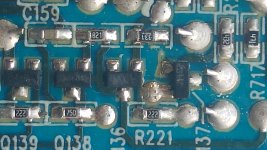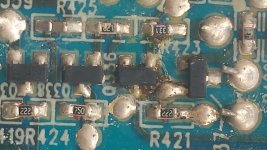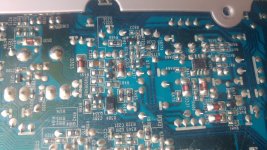Guys, hello.
I just bought some second hand NAD C326BEE amp.
Seller stated that he was only owner of this amp and had never take it to extreme or had any issues with it. So, it was a lie 🙂
As I understand this amp had bad times, but looks like got fixed.
It seems to be working fine, but my "fine" is not very reliable, as I am new to whole WIFI field 🙂
So, I will be glad to know if I spent my money for nothing (~250GBP).
Please look at the pictures and tell me what you can say about condition of this amp, what possibly happen to it in the past (some soldering work, overheating, water damage, other).
I think of doing some repairing work future (recapping, replacing some other elements).
Thanks a lot.
I just bought some second hand NAD C326BEE amp.
Seller stated that he was only owner of this amp and had never take it to extreme or had any issues with it. So, it was a lie 🙂
As I understand this amp had bad times, but looks like got fixed.
It seems to be working fine, but my "fine" is not very reliable, as I am new to whole WIFI field 🙂
So, I will be glad to know if I spent my money for nothing (~250GBP).
Please look at the pictures and tell me what you can say about condition of this amp, what possibly happen to it in the past (some soldering work, overheating, water damage, other).
I think of doing some repairing work future (recapping, replacing some other elements).
Thanks a lot.
Attachments
-
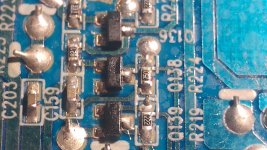 20200219_212842.jpg361.1 KB · Views: 374
20200219_212842.jpg361.1 KB · Views: 374 -
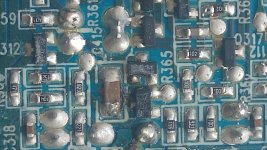 20200221_105525.jpg322.8 KB · Views: 166
20200221_105525.jpg322.8 KB · Views: 166 -
 20200219_215419.jpg370.5 KB · Views: 181
20200219_215419.jpg370.5 KB · Views: 181 -
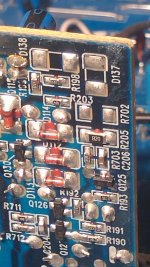 20200219_215407.jpg329.5 KB · Views: 201
20200219_215407.jpg329.5 KB · Views: 201 -
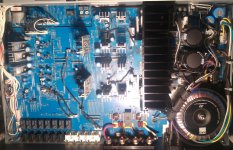 20200219_215110.jpg727.7 KB · Views: 211
20200219_215110.jpg727.7 KB · Views: 211 -
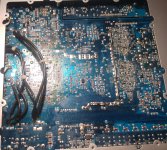 20200219_214734.jpg808.9 KB · Views: 230
20200219_214734.jpg808.9 KB · Views: 230 -
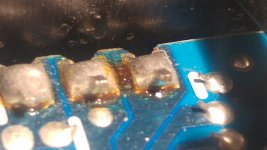 20200219_213338.jpg229.3 KB · Views: 359
20200219_213338.jpg229.3 KB · Views: 359 -
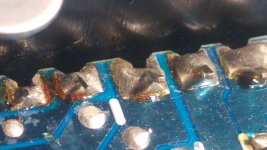 20200219_213323.jpg316.8 KB · Views: 348
20200219_213323.jpg316.8 KB · Views: 348 -
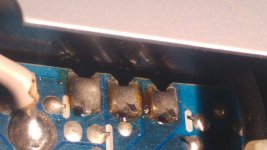 20200219_213243.jpg263.7 KB · Views: 355
20200219_213243.jpg263.7 KB · Views: 355 -
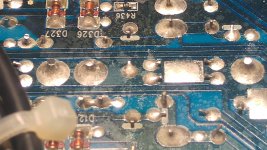 20200219_213228.jpg397.9 KB · Views: 366
20200219_213228.jpg397.9 KB · Views: 366
Last edited:
Looks like out of the factory to me but my crystal ball has the fog.
For a 10 year old amplifier it looks about right. What do you base the "lies" on, I wonder.
For a 10 year old amplifier it looks about right. What do you base the "lies" on, I wonder.
the conformal coating looks like it's taking on a milky appearance but that's nothing abnormal nor is the odd bit of solder resin.
what sort of fault does this amp have??
what sort of fault does this amp have??
JonSnell Electronic, thank you very much for the reply!
Maybe I am paranoid, but here is why I think it was a lie:
1) I see that many of big transistor joints (and few in other places on copper side) have not factory finish - flux is on them, ugly soldering work.
2) Whole board is covered with some substance (like dried out drops of water). This substance can not be removed with water or spirit. Not sure what is source of it.
3) Few legs of some transistors have touch of soldering iron (with residue of flux too) - some ugly soldering work that was done.
4) Some PCB contacts are partially naked (see first picture in top post). Not sure why it can happen. Due to bad factory soldering? Due to overheating (it happened it at places where PCB got hot - under stages of amplifier)?
Do you guys think this can be issue? Maybe I should re-solder these legs? Maybe replace all these SMD transistors? Can they be damaged by overheating of PCB there?
5) Voltages across TP1 & TP2 and TP3 & TP4 (idle current measuring contacts) are ~ 10 mV instead of 3-3.5 mV that is required by manual. I don't know if these voltages rises with time. Any way lowering these voltages (idle current) will lead to extra heating and probably someone lowered these voltages on purpose to keep the amp cooler).
Maybe I am paranoid, but here is why I think it was a lie:
1) I see that many of big transistor joints (and few in other places on copper side) have not factory finish - flux is on them, ugly soldering work.
2) Whole board is covered with some substance (like dried out drops of water). This substance can not be removed with water or spirit. Not sure what is source of it.
3) Few legs of some transistors have touch of soldering iron (with residue of flux too) - some ugly soldering work that was done.
4) Some PCB contacts are partially naked (see first picture in top post). Not sure why it can happen. Due to bad factory soldering? Due to overheating (it happened it at places where PCB got hot - under stages of amplifier)?
Do you guys think this can be issue? Maybe I should re-solder these legs? Maybe replace all these SMD transistors? Can they be damaged by overheating of PCB there?
5) Voltages across TP1 & TP2 and TP3 & TP4 (idle current measuring contacts) are ~ 10 mV instead of 3-3.5 mV that is required by manual. I don't know if these voltages rises with time. Any way lowering these voltages (idle current) will lead to extra heating and probably someone lowered these voltages on purpose to keep the amp cooler).
Thanks a lot for reply!the conformal coating looks like it's taking on a milky appearance but that's nothing abnormal nor is the odd bit of solder resin.
what sort of fault does this amp have??
OK, these are great news about this milky stuff)
For now I see no issues, but I did not test if properly (for exact amp gain, for distortions, etc).
Problem is that I still have no good speakers to test this amp.
Just looking on some soldering joints made me think that this amp was already serviced/fixed in the past.
stop worrying about the amp focus your time and energy into finding the speakers you say you need!
NAD amp was made by OEM factory, all the PCB look like this at the year of it's production.
Well, I saw much better quality builds on cheaper stuff 🙂 But thanks for the info any way.
stop worrying about the amp focus your time and energy into finding the speakers you say you need!
Haha, this is what I am doing currently )
Thinking to go with new B&W 606 or Dali Oberon 3.
Still need to listen to both with my amp.
5) Voltages across TP1 & TP2 and TP3 & TP4 (idle current measuring contacts) are ~ 10 mV instead of 3-3.5 mV that is required by manual. I don't know if these voltages rises with time. Any way lowering these voltages (idle current) will lead to extra heating and probably someone lowered these voltages on purpose to keep the amp cooler).
Bias does drift with time. You say that the voltages are higher (10mV) but then "probably someone lowered these voltages on purpose to keep the amp cooler". This makes no sense as lowering your idle current doesn't make the amp run hotter and the voltages are higher than spec anyway..
TP1 to TP2 contains 2x 0.05 ohm resistors. So I=V/R, I = 0.0035 / 0.1 = 35mA which is a typical bias setting. your setting of 10mV corresponds with 100mA which is usually on the high side.
I think of doing some repairing work future (recapping, replacing some other elements).
I would just enjoy the amp as is. Without proper skill and knowledge, you can easily damage or destroy an otherwise perfectly good amp. At most, reset the idle bias to the correct value as per the service manual spec and then just enjoy the amp with some nice matching speakers.
Guys, thank you for replies!
avtech23 , good clarification )
How do you see that TP1 to TP2 contains 2x 0.05 ohm resistors?
MAAC0, yes, looks like it will be good to do. On other hand maybe I should leave everything as is (I can accidental damage circuitry when cleaning).
avtech23 , good clarification )
How do you see that TP1 to TP2 contains 2x 0.05 ohm resistors?
MAAC0, yes, looks like it will be good to do. On other hand maybe I should leave everything as is (I can accidental damage circuitry when cleaning).
avtech23, thank you very much for the comments!
I need to get more familiar with service manual diagrams.
So, from what I understand right now current limit is set to 3 times of normal values.
Some more question, please.
1) Is higher value of this current something that can lead to better sound?
2) Is higher value of this current something that can lead to extra heating?
3) Can this current become x3 times higher with time without any intentional intervention? Just because of degrading of components or other reason?
In other words - do you think this high value is result of "overlocking" of amp by somebody to get better performance?
I need to get more familiar with service manual diagrams.
So, from what I understand right now current limit is set to 3 times of normal values.
Some more question, please.
1) Is higher value of this current something that can lead to better sound?
2) Is higher value of this current something that can lead to extra heating?
3) Can this current become x3 times higher with time without any intentional intervention? Just because of degrading of components or other reason?
In other words - do you think this high value is result of "overlocking" of amp by somebody to get better performance?
I'll also add that those boards look original to me. The soldering looks original on the output devices and the deposits on the board are something I've seen before. It may not look ideal but it does look original.
I'm going to beg to differ with the comment that bias changes or drifts over time and ask by what mechanism that may occur?
Passive parts are stable and the semiconductors unchanging in their characteristics year on year. The biggest problem many have checking the bias is in not being able to replicate the test conditions exactly.
Setting the bias at anything other than the recommended value is inadvisable. Increasing it will not gain you anything apart from more heat and possibly more distortion (not less) as the output levels increase. If you suspect the bias has been altered by someone then I would just reset to the correct value and forget about it.
I'm going to beg to differ with the comment that bias changes or drifts over time and ask by what mechanism that may occur?
Passive parts are stable and the semiconductors unchanging in their characteristics year on year. The biggest problem many have checking the bias is in not being able to replicate the test conditions exactly.
Setting the bias at anything other than the recommended value is inadvisable. Increasing it will not gain you anything apart from more heat and possibly more distortion (not less) as the output levels increase. If you suspect the bias has been altered by someone then I would just reset to the correct value and forget about it.
You're welcome 🙂
Just make any cheques payable to Barclays Bank Acc 121345678
😉
Where is the Like button here..?
Just make any cheques payable to Barclays Bank Acc 121345678
😉
Reading more about idle currents/voltages.
This article from 2001 (Adjusting the Bias Of Your Amp [English]) says that variable resistors (that are responsible for regulating idle currents values) can degrade with time, leading to higher voltages. My amp has very simple trim potentiometers, so I guess this can be possible reason for idle currents values become 3 times higher then required by service manual.
Interesting fact is that both channels has SAME values of current/voltage of 10mV (100mA in my case).
There are more reliable potentiometers. But I did not find yet which models are considered "good" enough for audio amps.
This article from 2001 (Adjusting the Bias Of Your Amp [English]) says that variable resistors (that are responsible for regulating idle currents values) can degrade with time, leading to higher voltages. My amp has very simple trim potentiometers, so I guess this can be possible reason for idle currents values become 3 times higher then required by service manual.
Interesting fact is that both channels has SAME values of current/voltage of 10mV (100mA in my case).
There are more reliable potentiometers. But I did not find yet which models are considered "good" enough for audio amps.
- Home
- Amplifiers
- Solid State
- Diagnose of my AMP, please
